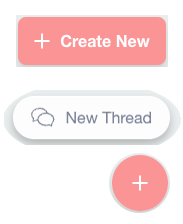We’d like to remind Forumites to please avoid political debate on the Forum.
This is to keep it a safe and useful space for MoneySaving discussions. Threads that are – or become – political in nature may be removed in line with the Forum’s rules. Thank you for your understanding.
📨 Have you signed up to the Forum's new Email Digest yet? Get a selection of trending threads sent straight to your inbox daily, weekly or monthly!
Help with debt management
feygan
Posts: 51 Forumite
My partner and I currently owe a little under £7500 between us. This is split roughly as follows;
50% static loans from family who we have standing orders set up for& default repayment agreements.
35% Interest style leans & store/credit cards.
15% Constant amount interest debt.
We have been steadily reducing our total debts we regular payments split amongst these, however we are seeking to fine tune things to ensure we pay off some debts sooner and pay less interest. With that in mind we are hoping someone can tell us any possible methods for maximising our repayment efforts.
Since the default agreements will have no effect on our personal credit ratings no matter how fast we repay them we have setup payment plans for a minimal amount so they will be repaid in full before the six year time limit expires for the default to be removed. The family loans we are lucky in that it has been perfectly amicable with no problems, as such they are set at an amount agreeable for us and the family members who lent us money.
This leaves the store/credit cards and our constant rate interest. The constant rate issue comes from a Santander current account which has an authorised overdraft. Unfortunately they charge £20 per month (£1 per day regardless of the amount overdrawn). Then the other cards fluctuate their interest amounts each month due to our repayments, but all are under £20 each month.
I am of the belief that generally it is best to repay things with high interests first, but would this just mean paying back the debts with the highest APR or the highest actual monetary figure each month? For example one of our cards is a very high APR (32%), but it's monthly interest is less than the Santander account. So would we be best off paying only the minimum amount on all our cards while concerntrating on the overdraft, and then switching each month so we put all our spare cash in to which ever card has the highest monetary figure?
Hope I have explained fully the issue and thanks for any help offered.
50% static loans from family who we have standing orders set up for& default repayment agreements.
35% Interest style leans & store/credit cards.
15% Constant amount interest debt.
We have been steadily reducing our total debts we regular payments split amongst these, however we are seeking to fine tune things to ensure we pay off some debts sooner and pay less interest. With that in mind we are hoping someone can tell us any possible methods for maximising our repayment efforts.
Since the default agreements will have no effect on our personal credit ratings no matter how fast we repay them we have setup payment plans for a minimal amount so they will be repaid in full before the six year time limit expires for the default to be removed. The family loans we are lucky in that it has been perfectly amicable with no problems, as such they are set at an amount agreeable for us and the family members who lent us money.
This leaves the store/credit cards and our constant rate interest. The constant rate issue comes from a Santander current account which has an authorised overdraft. Unfortunately they charge £20 per month (£1 per day regardless of the amount overdrawn). Then the other cards fluctuate their interest amounts each month due to our repayments, but all are under £20 each month.
I am of the belief that generally it is best to repay things with high interests first, but would this just mean paying back the debts with the highest APR or the highest actual monetary figure each month? For example one of our cards is a very high APR (32%), but it's monthly interest is less than the Santander account. So would we be best off paying only the minimum amount on all our cards while concerntrating on the overdraft, and then switching each month so we put all our spare cash in to which ever card has the highest monetary figure?
Hope I have explained fully the issue and thanks for any help offered.
0
Comments
-
Hi feygan :wave:
Firstly, i think you should fill out an SOA, this will allow us to see your full financial situation and we'll hopefully be able to give you more constructive advice then. Go here: http://www.stoozing.com/calculator/soa.php, fill out the form, select "Process" then "MSE" and paste the result back into this thread. I'm sure we can find some spare ££ from somewhere!
Regarding your interest payments. You're right that generally the highest interest is the one you want to get rid of first because that's actually adding more onto your current debt (i.e. You'll end up paying more than you owe). Saying that, as you point out, it's all relative. If you owe £200 on a 39.9% APR card, but owe £5000 on a 19.9% APR card; then although it's not the highest interest, it's the larger of the 2 debts that's actually costing you the most money each month.
Pop up your SOA and i'm sure we can sort something for you. It all takes time and time is money,
It all takes time and time is money,
money talks and talk is cheap.
- David Ford0 -
Here is a result from the stoozing site.
Statement of Affairs and Personal Balance Sheet
Household Information
Number of adults in household........... 2
Number of cars owned.................... 1
Monthly Income Details
Monthly income after tax................ 1770
Total monthly income.................... 1770
Monthly Expense Details
Rent.................................... 350
Electricity............................. 50
Oil..................................... 60
Mobile phone............................ 58
Internet Services....................... 45
Groceries etc. ......................... 240
Petrol/diesel........................... 80
Road tax................................ 12
Car Insurance........................... 30
Car maintenance (including MOT)......... 12
Pet insurance/vet bills................. 15
Total monthly expenses.................. 952
Assets
Cash.................................... 0
House value (Gross)..................... 0
Shares and bonds........................ 0
Car(s).................................. 0
Other assets............................ 0
Total Assets............................ 0
No Secured nor Hire Purchase Debts
Unsecured Debts
Description....................Debt......Monthly...APR
overdrafts.....................800.......25........0
store card 1...................250.......105.......0
tax credit overpay.............125.......20........0
loan...........................2048......82........0
defaults.......................364.......30........0
credit card 4..................930.......25........20
credit card 3..................200.......5.........34.9
credit card 1..................518.......20........35.9
credit card 1..................513.......20........35.9
budget loan payment............185.......15........0
Total unsecured debts..........5933......347.......-
Monthly Budget Summary
Total monthly income.................... 1,770
Expenses (including HP & secured debts). 952
Available for debt repayments........... 818
Monthly UNsecured debt repayments....... 347
Amount left after debt repayments....... 471
Personal Balance Sheet Summary
Total assets (things you own)........... 0
Total HP & Secured debt................. -0
Total Unsecured debt.................... -5,933
Net Assets.............................. -5,933
Created using the SOA calculator at https://www.stoozing.com.
Reproduced on Moneysavingexpert with permission, using Firefox browser.
We already were aware we have quite a large amount of spare income so we are looking for the most effective way to use it.0 -
Made a couple of error so here it is again but corrected.
Statement of Affairs and Personal Balance Sheet
Household Information
Number of adults in household........... 2
Number of children in household.........
Number of cars owned.................... 1
Monthly Income Details
Monthly income after tax................ 1770
Partners monthly income after tax....... 0
Benefits................................ 0
Other income............................ 0
Total monthly income.................... 1770
Monthly Expense Details
Mortgage................................ 0
Secured/HP loan repayments.............. 0
Rent.................................... 350
Management charge (leasehold property).. 0
Council tax............................. 0
Electricity............................. 50
Gas..................................... 0
Oil..................................... 60
Water rates............................. 0
Telephone (land line)................... 0
Mobile phone............................ 58
TV Licence.............................. 0
Satellite/Cable TV...................... 0
Internet Services....................... 45
Groceries etc. ......................... 240
Clothing................................ 0
Petrol/diesel........................... 80
Road tax................................ 12
Car Insurance........................... 30
Car maintenance (including MOT)......... 12
Car parking............................. 0
Other travel............................ 0
Childcare/nursery....................... 0
Other child related expenses............ 0
Medical (prescriptions, dentist etc).... 0
Pet insurance/vet bills................. 15
Buildings insurance..................... 0
Contents insurance...................... 0
Life assurance ......................... 0
Other insurance......................... 0
Presents (birthday, christmas etc)...... 0
Haircuts................................ 0
Entertainment........................... 0
Holiday................................. 0
Emergency fund.......................... 0
Total monthly expenses.................. 952
Assets
Cash.................................... 0
House value (Gross)..................... 0
Shares and bonds........................ 0
Car(s).................................. 0
Other assets............................ 0
Total Assets............................ 0
No Secured nor Hire Purchase Debts
Unsecured Debts
Description....................Debt......Monthly...APR
overdrafts.....................800.......25........0
store card.....................250.......105.......0
tax credit overpay.............125.......20........0
budget loan payment............185.......15........0
credit card 4..................513.......5.........35.9
credit card 3..................518.......5.........35.9
credit card 2..................150.......5.........34.9
credit card 1..................930.......25........20
defaults.......................364.......30........0
loan...........................2048......82........0
Total unsecured debts..........5883......317.......-
Monthly Budget Summary
Total monthly income.................... 1,770
Expenses (including HP & secured debts). 952
Available for debt repayments........... 818
Monthly UNsecured debt repayments....... 317
Amount left after debt repayments....... 501
Personal Balance Sheet Summary
Total assets (things you own)........... 0
Total HP & Secured debt................. -0
Total Unsecured debt.................... -5,883
Net Assets.............................. -5,883
The storcard is a non mover as it is a 0% interest deal and this amount is what is required for us to pay back the sum before the 0% period expires. The defaults, loan, tax credit & budget loan payments are fixed agreements that we could reduce if needed but do not see them as a priority as they are costing of nothing extra in interest.
This leaves us with the overdraft charges and the credit cards, the cards do end up being more than an actual £5 monthly payment as the interest pushes it up normally in the region of £15. I have listed the general expenses pretty much as we do them here as such there is nothing that can be cut back from there.
0 -
Hello there,
There are plenty of sections within the budget which really good do with something being listed. What's important is that the budget is realistic and sustainable. This means that you should consider amounts for items such as clothing, haircuts, entertainment, emergencies and so on. Then you'll be able to see exactly how much you have left to offer your creditors. The thing to then do would be to overpay the debts with the highest interest rates first, this is known as 'snowballing'. There's a great explanation about the process on the Debt Camel site:
http://debtcamel.co.uk/debt-options/snowball/
Best wishes,
David @ NDL.We work as money advisers for National Debtline and have specific permission from MSE to post to try to help those in debt. Read more information on National Debtline in MSE's Debt Problems: What to do and where to get help guide. If you find you're struggling with debt and need further help try our online advice tool My Money Steps0
This discussion has been closed.
Confirm your email address to Create Threads and Reply

Categories
- All Categories
- 352K Banking & Borrowing
- 253.5K Reduce Debt & Boost Income
- 454.2K Spending & Discounts
- 245K Work, Benefits & Business
- 600.6K Mortgages, Homes & Bills
- 177.4K Life & Family
- 258.8K Travel & Transport
- 1.5M Hobbies & Leisure
- 16.2K Discuss & Feedback
- 37.6K Read-Only Boards
